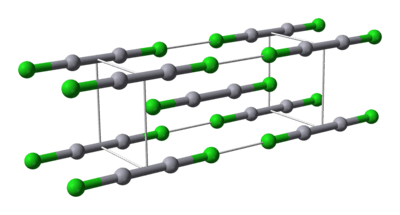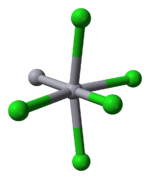Mercury(I) chloride
 | |
| | |
 | |
| Names | |
|---|---|
| IUPAC name
Dimercury dichloride | |
| Other names
Mercurous chloride Calomel | |
| Identifiers | |
| 10112-91-1 | |
| 3D model (Jmol) | Interactive image |
| ChEBI | CHEBI:33050 |
| ChemSpider | 16740467 |
| ECHA InfoCard | 100.028.574 |
| EC Number | 233-307-5 |
| PubChem | 24956 |
| RTECS number | OV8750000 |
| UNII | J2D46N657D |
| UN number | 3077 |
| |
| |
| Properties | |
| Hg2Cl2 | |
| Molar mass | 472.09 g/mol |
| Appearance | White solid |
| Density | 7.150 g/cm3 |
| Melting point | 525 °C (977 °F; 798 K) (triple point) |
| Boiling point | 383 °C (721 °F; 656 K) (sublimes) |
| 0.2 mg/100 mL | |
| Solubility | insoluble in ethanol, ether |
| Refractive index (nD) |
1.973 |
| Hazards | |
| Safety data sheet | ICSC 0984 |
| EU classification (DSD) |
Harmful (Xn) Dangerous for the environment (N) |
| R-phrases | R22, R36/37/38, R50/53 |
| S-phrases | (S2), S13, S24/25, S46, S60, S61 |
| NFPA 704 | |
| Flash point | Non-flammable |
| Lethal dose or concentration (LD, LC): | |
| LD50 (median dose) |
210 mg/kg (rat, oral)[1] |
| Thermochemistry | |
| Std molar entropy (S |
196 J·mol−1·K−1[2] |
| Std enthalpy of formation (ΔfH |
−265 kJ·mol−1[2] |
| Related compounds | |
| Other anions |
Mercury(I) fluoride Mercury(I) bromide Mercury(I) iodide |
| Other cations |
Mercury(II) chloride |
| Except where otherwise noted, data are given for materials in their standard state (at 25 °C [77 °F], 100 kPa). | |
| | |
| Infobox references | |
Mercury(I) chloride is the chemical compound with the formula Hg2Cl2. Also known as calomel[3] (a mineral form, rarely found in nature) or mercurous chloride, this dense white or yellowish-white, odorless solid is the principal example of a mercury(I) compound. It is a component of reference electrodes in electrochemistry.[4][5]
History
The name calomel is thought to come from the Greek καλός beautiful, and μέλας black; or καλός and μέλι honey from its sweet taste.[3] The black name (somewhat surprising for a white compound) is probably due to its characteristic disproportionation reaction with ammonia, which gives a spectacular black coloration[3] due to the finely dispersed metallic mercury formed. It is also referred to as the mineral horn quicksilver[3] or horn mercury. Calomel was taken internally and used as a laxative,[3] for example to treat George III in 1801, and disinfectant, as well as in the treatment of syphilis, until the early twentieth century. Until fairly recently it was also used as a horticultural fungicide, most notably as a root dip to help prevent the occurrence of clubroot amongst crops of the Brassicaceae family.[6]
Mercury became a popular remedy for a variety of physical and mental ailments during the age of "heroic medicine." It was used by doctors in America throughout the eighteenth century, and during the revolution, to make patients regurgitate and release their body from "impurities". Benjamin Rush was one particular well-known advocate of mercury in medicine and used calomel to treat sufferers of yellow fever during its outbreak in Philadelphia in 1793. Calomel was given to patients as a purgative or cathartic until they began to salivate and was often administered to patients in such great quantities that their hair and teeth fell out.[7] Shortly after yellow fever struck Philadelphia, the disease broke out in Jamaica. A war of words erupted in the press concerning the best treatment for yellow fever; bleeding or calomel. Anecdotal evidence indicates calomel was more effective than bleeding.[8]
Properties
Mercury is unique among the group 12 metals for its ability to form the M–M bond so readily. Hg2Cl2 is a linear molecule. The mineral calomel crystallizes in the tetragonal system, with space group I4/m 2/m 2/m. The unit cell of the crystal structure is shown below:
 |  |
| |
The Hg–Hg bond length of 253 pm (Hg–Hg in the metal is 300 pm) and the Hg–Cl bond length in the linear Hg2Cl2 unit is 243 pm.[9] The overall coordination of each Hg atom is octahedral as, in addition to the two nearest neighbours, there are four other Cl atoms at 321 pm. Longer mercury polycations exist.
Preparation and reactions
Mercurous chloride forms by the reaction of elemental mercury and mercuric chloride:
- Hg + HgCl2 → Hg2Cl2
It can be prepared via metathesis reaction involving aqueous mercury(I) nitrate using various chloride sources including NaCl or HCl.
- 2HCl + Hg2(NO3)2 → Hg2Cl2 + 2HNO3
Ammonia causes Hg2Cl2 to disproportionate:
- Hg2Cl2 + 2NH3 → Hg + Hg(NH2)Cl + NH4Cl
Calomel electrode
Mercurous chloride is employed extensively in electrochemistry, taking advantage of the ease of its oxidation and reduction reactions. The calomel electrode is a reference electrode, especially in older publications. Over the past 50 years, it has been superseded by the silver/silver chloride (Ag/AgCl) electrode. Although the mercury electrodes have been widely abandoned due to the dangerous nature of mercury, many chemists believe they are still more accurate and are not dangerous as long as they are handled properly. The differences in experimental potentials vary little from literature values. Other electrodes can vary by 70 to 100 millivolts.
Photochemistry
Mercurous chloride decomposes into mercury(II) chloride and elemental mercury upon exposure to UV light.
- Hg2Cl2 → HgCl2 + Hg
The formation of Hg can be used to calculate the number of photons in the light beam, by the technique of actinometry. By utilizing a light reaction in the presence of mercury(II) chloride and ammonium oxalate, mercury(I) chloride, ammonium chloride and carbon dioxide is produced.
- 2HgCl2 + (NH4)2C2O4 + Light → Hg2Cl2(s) + 2[NH4+][Cl−] + 2CO2
This particular reaction was discovered by J.M. Eder (hence the name Eder reaction) in 1880 and reinvestigated by W. E. Rosevaere in 1929.[10]
Related mercury(I) compounds
Mercury(I) bromide, Hg2Br2, is a light yellow, whereas mercury(I) iodide, Hg2I2, is greenish in colour. Both are poorly soluble. Mercury(I) fluoride is unstable in the absence of a strong acid.
Safety considerations
Mercurous chloride is toxic, although due to its low solubility in water it is generally less dangerous than its mercuric chloride counterpart. It was used in medicine as a diuretic and purgative (laxative) in the United States from the late 1700s through the 1860s. Calomel was also a common ingredient in teething powders in Britain up until 1954, causing widespread mercury poisoning in the form of pink disease, which at the time had a mortality rate of 1 in 10.[11] These medicinal uses were later discontinued when the compound's toxicity was discovered.
It has also found uses in cosmetics as soaps and skin lightening creams, but these preparations are now illegal to manufacture or import in many countries including the US, Canada, Japan and the European Union.[12] A study of workers involved in the production of these preparations showed that the sodium salt of 2,3-dimercapto-1-propanesulfonic acid (DMPS) was effective in lowering the body burden of mercury and in decreasing the urinary mercury concentration to normal levels.[13]
References
- ↑ "Mercury compounds [except (organo) alkyls] (as Hg)". Immediately Dangerous to Life and Health. National Institute for Occupational Safety and Health (NIOSH).
- 1 2 Zumdahl, Steven S. (2009). Chemical Principles 6th Ed. Houghton Mifflin Company. p. A22. ISBN 0-618-94690-X.
- 1 2 3 4 5
 Chisholm, Hugh, ed. (1911). "Calomel". Encyclopædia Britannica (11th ed.). Cambridge University Press.
Chisholm, Hugh, ed. (1911). "Calomel". Encyclopædia Britannica (11th ed.). Cambridge University Press. - ↑ Housecroft, C. E.; Sharpe, A. G. (2004). Inorganic Chemistry (2nd ed.). Prentice Hall. pp. 696–697. ISBN 978-0130399137.
- ↑ Skoog, Douglas A.; Holler, F. James; Nieman, Timothy A. (1998). Principles of Instrumental Analysis (5th ed.). Saunders College Pub. pp. 253–271. ISBN 0-03-002078-6.
- ↑ Buczacki, S., Pests, Diseases and Disorders of Garden Plants, Collins, 1998, pp 449-50. ISBN 0-00-220063-5
- ↑ Koehler, Christopher S. W. (January 2001). "Heavy Metal Medicine". Today's Chemist at Work. American Chemical Society. 10 (1): 61–65. ISSN 1062-094X. Retrieved 2009-02-02.
- ↑ Johnston, Elizabeth Lichtenstein (1901). Recollections of a Georgia Loyalist...written in 1836. New York: Mansfield & Company. pp. 82-83.
- ↑ Wells A.F. (1984) Structural Inorganic Chemistry 5th edition Oxford Science Publications ISBN 0-19-855370-6
- ↑ Roseveare, W. E. (1930). "The X-Ray Photochemical Reaction between Potassium Oxalate and Mercuric Chloride". J. Am. Chem. Soc. 52 (7): 2612–2619. doi:10.1021/ja01370a005.
- ↑ Sneader, Walter (2005). Drug Discovery: A History. John Wiley and Sons. pp. 45–46. ISBN 0-471-89980-1. Retrieved 2009-02-02.
- ↑ "Commission Directive 86/199/EEC, OJ L 149, p. 38 of 3.6.1986".
- ↑ D. Gonzalez-Ramirez, M. Zuniga-Charles, A. Narro-Juarez, Y. Molina-Recio, K. M. Hurlbut, R. C. Dart and H. V. Aposhian (1 October 1998). "DMPS (2,3-Dimercaptopropane-1-sulfonate, Dimaval) Decreases the Body Burden of Mercury in Humans Exposed to Mercurous Chloride" (free full text). Journal of Pharmacology and Experimental Therapy. 287 (1): 8–12. PMID 9765315.
External links
| Wikimedia Commons has media related to Mercury(I) chloride. |
- International Chemical Safety Card 0984
- National Pollutant Inventory - Mercury and compounds Fact Sheet
- NIOSH Pocket Guide to Chemical Hazards
